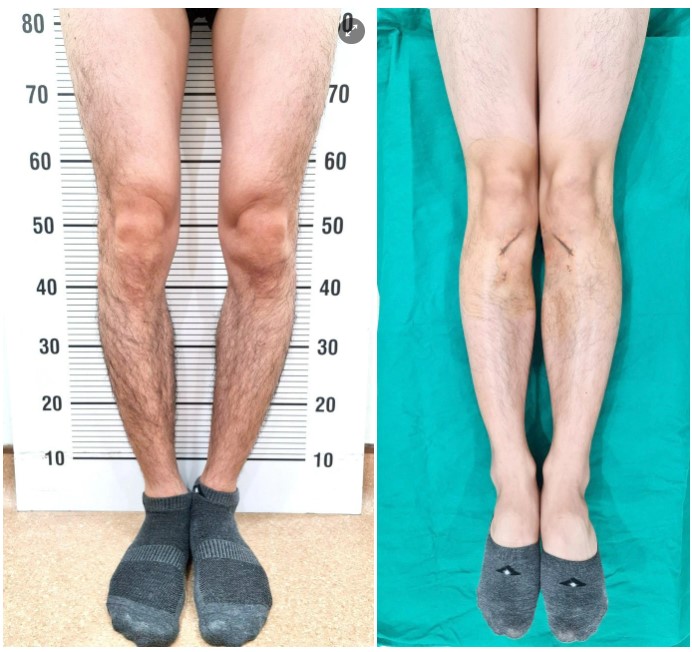According to Assoc. Prof., Dr. Le Van Doan, methods for bow leg correction include dietary modifications, exercising, physical therapy and orthopedic surgery.
Bow leg is a condition where the knee is pointed out and the leg is bent, causing the ankles to be close together and the knees to be far apart when standing straight. Bow legs often come from causes such as genetics, malnutrition, being overweight, or some diseases of the joints.
Parents with bow legs have a higher chance of passing this deformity to their babies. Bow legs can also develop in children who have chronic calcium and vitamin D deficiencies. Babies with excess weight who learn to walk too soon are also more likely to develop bow legs. Bow legs can also be caused by rickets, osteogenesis imperfecta, fractures that are displaced near the knee joint, injuries that cause cartilage damage, and other conditions.
With more than 30 years of experience in the field of surgery and orthopedics, Assoc. Prof., Dr. Le Van Doan has pointed out a number of solutions that can assist people with bow legs to improve this deformity.
Dietary Modifications
One of the causes of bow legs is nutritional deficiencies. Therefore, adjusting the diet and supplementing with suitable substances is a positive solution to solve the issue.
In the daily diet, nutritionists recommend that people with bow legs should increase protein, vitamins, and minerals, especially calcium, vitamin D3, MK7, etc. These substances support the treatment and prevention of rickets and malnutrition while assisting the body’s improved calcium absorption, enhancing bone strength and flexibility.
The following foods should be on the menu because they are high in nutrients and good for bones: shrimp, crab, eggs, milk, fish, etc.

Image of bow legs
Exercising
To improve their bow legs, children need to be encouraged to be active and play sports regularly. Some simple exercises, easy to do at home, such as tiptoe exercises, squats, glute stretching exercises, and using massage rollers, etc, are also recommended.
Regularly performing these exercises will strengthen the legs, ease knee pain, tone the muscles, adjust the knee inward, improve ligament and tendon structure elasticity, etc.
Physical Therapy
Children with bow legs should be taken to medical facilities with specialized physical therapists to get their legs corrected. Depending on the degree of curvature, the doctor will prescribe a physical therapy regimen that includes exercises ranging from simple to complex movements to start the correction.
Exercises will be performed under the guidance and prescription of qualified doctors and rehabilitation technicians. Some basic physical therapy exercises that can be referred to are using leg belts or leg press.
Orthopedic surgery for bow legs
Orthopedic surgery is a successful treatment option when the aforementioned measures fail to improve the condition and the bones and joints have stabilized by the time the patient is 19 to 20 years old. The leg shaft will be surgically adjusted to be straight, attractive, and to enhance the figure. Additionally, this solution aids in weight adjustment to properly focus on the joints, preventing later-onset osteoarthritis of the knee and ankle.

According to Dr. Doan, a bow leg operation typically lasts two hours. A bone is usually cut below the knee, where it is most curved, and then straightened by the surgeon. Depending on the degree of the deformity, the legs will be 1-2 cm longer. Bone from either the donor or the patient will be used to fill the gap. The bone is firmly fixed by the locking screw brace.
After five days of surgery, the patient will be able to stand up and practice walking. After 3-4 weeks, the patient can begin to walk slowly. After 2-3 months, the patient can be active and exercise like a normal person.
Assoc. Prof., Dr. Le Van Doan has successfully performed hundreds of surgeries to correct deformities of the legs and arms, including many cases of severe bow legs. This is a type of surgery that is not too difficult but requires a specialist in orthopedics to avoid complications.
At the same time, this type of surgery needs to be performed at a hospital with modern medical equipment, with a team of highly skilled doctors and technicians, and with dedicated care to guarantee safety and good results.


